2006 Suzuki GSX-R600 - Precision Service & Repair Manual
Product Gallery
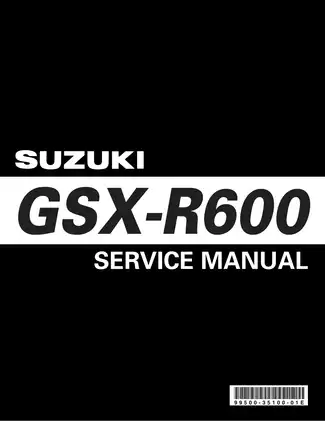
Sample pages from the 2006 Suzuki GSX-R600 - Precision Service & Repair Manual manual

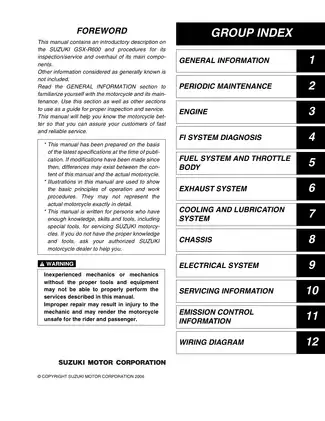
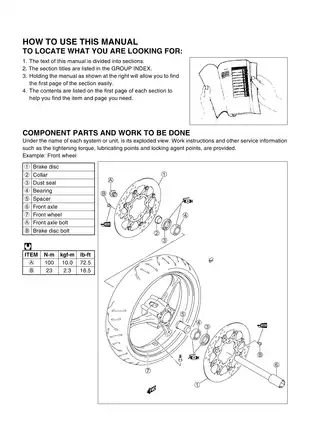
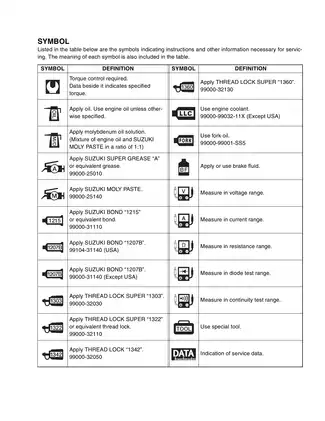
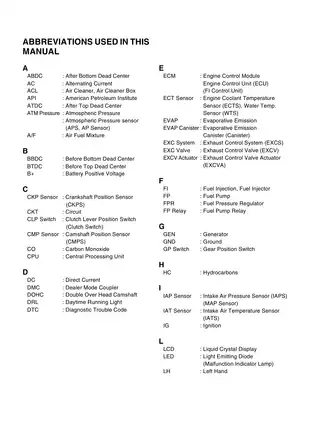
Purchase Information
Suzuki GSX-R600 2006 Service Manual - Comprehensive Maintenance & Repair Guide - Technical Specifications
- File Size:
- 47.88 MB
- File Type:
- Language:
- English
- Printable:
- Yes
- Estimated Download Time:
- 0.98 Minutes
- Delivery Format:
- Digital (PDF) - Instant Access
- Category:
- Motorcycle
- Brand:
- Suzuki
Suzuki Models and Parts Covered in this Motorcycle Manual
- Suzuki GSX-R600 (2006)
Complete Manual Information
Suzuki GSX-R600 2006 Service Manual
The Suzuki GSX-R600 2006 Service Manual is an essential resource for any motorcycle enthusiast or mechanic looking to maintain or repair this iconic sport bike. This detailed manual covers all aspects of servicing, from routine maintenance to complex repairs, ensuring you have the knowledge needed to keep your bike in top shape.
Key Features:
- Detailed Procedures: Step-by-step instructions for service and maintenance, including periodic checks and adjustments.
- Diagnosis and Troubleshooting: Comprehensive troubleshooting guides for diagnosing performance issues and resolving common problems.
- Wiring Diagrams: Clear wiring diagrams to help with electrical repairs and modifications.
- Specifications: Complete technical specifications for all components of the GSX-R600, including torque settings and fluid capacities.
What's Inside:
- Foreword
- General Information
- Periodic Maintenance
- Engine Repair
- Fuel System
- Electrical System
- Electrical Parts Inspection
- Wiring Diagrams
- Self-Diagnostic Procedures
This manual is designed not only for experienced mechanics but also for DIY enthusiasts who may be tackling their first motorcycle repair. It includes safety tips to ensure everything is done properly and safely. Whether you need to replace a fuel filter, adjust the throttle positioning, or perform a complete engine overhaul, this manual has you covered.
Also available are high-quality illustrations which offer a visual representation of each procedure, making it easier to follow and comprehend complex tasks. Prepare to avoid costly mistakes by referring to this manual, ensuring your GSX-R600 performs at its best!
Download Instructions for Suzuki Motorcycle Manual
Frequently Asked Questions - Suzuki Motorcycle Manual
What does this Suzuki manual cover?
This comprehensive service manual covers detailed repair procedures, maintenance schedules, troubleshooting guides, and technical specifications for 2006 Suzuki GSX-R600 - Precision Service & Repair Manual. It includes information for the following models: * Suzuki GSX-R600 (2006).
Is this manual suitable for beginners?
Yes, this Suzuki manual is designed for both professional technicians and DIY enthusiasts. It includes step-by-step procedures with clear illustrations and safety guidelines for Motorcycle maintenance and repair.
What file format will I receive?
You will receive this manual as a PDF file (47.88 MB), which is compatible with all devices. The manual is fully searchable and printable for your convenience.
How quickly can I access the manual after purchase?
You'll receive instant access to your Suzuki Motorcycle manual immediately after payment completion. The download link is valid for 3 days, with lifetime re-download guarantee.
Are engine specifications included?
This motorcycle service manual includes detailed engine specifications, valve clearances, torque settings, and performance data specific to your Suzuki model.
Can I print specific sections of the manual?
Absolutely! This digital manual allows you to print any section you need, from individual pages to complete chapters, making it perfect for workshop use.
Customer Reviews and Feedback
Read what our customers say about this Suzuki Motorcycle manual and share your own experience.
Add Comment
This policy contains information about your privacy. By posting, you are declaring that you understand this policy:
- Your name, rating, website address, town, country, state and comment will be publicly displayed if entered.
- Aside from the data entered into these form fields, other stored data about your comment will include:
- Your IP address (not displayed)
- The time/date of your submission (displayed)
- Your email address will not be shared. It is collected for only two reasons:
- Administrative purposes, should a need to contact you arise.
- To inform you of new comments, should you subscribe to receive notifications.
- A cookie may be set on your computer. This is used to remember your inputs. It will expire by itself.
This policy is subject to change at any time and without notice.
These terms and conditions contain rules about posting comments. By submitting a comment, you are declaring that you agree with these rules:
- Although the administrator will attempt to moderate comments, it is impossible for every comment to have been moderated at any given time.
- You acknowledge that all comments express the views and opinions of the original author and not those of the administrator.
- You agree not to post any material which is knowingly false, obscene, hateful, threatening, harassing or invasive of a person's privacy.
- The administrator has the right to edit, move or remove any comment for any reason and without notice.
Failure to comply with these rules may result in being banned from submitting further comments.
These terms and conditions are subject to change at any time and without notice.
Comments (4)